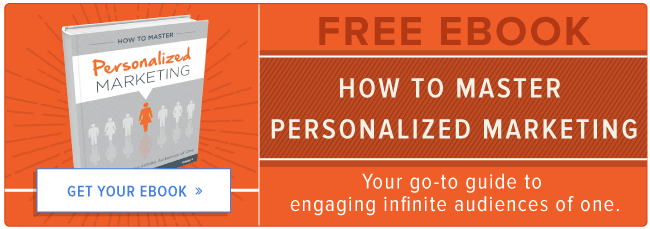

Whenever I have the opportunity to chat with a thought leader in the marketing industry, I always like to ask: What trend do you think will be next year’s buzzword?
In 2014, many professionals said 2015 would be the year of personalization — a prediction that, as it turns out, may have been a little too hopeful.
There are a few reasons personalization hasn’t taken off as well as anticipated, but not one of these reasons is a reluctance to personalize. It’s not a matter of failing to grasp the merits of creating more relevant and better-targeted messaging, but a matter of mastering everyone’s other favorite buzzword and slated 2016 MVP: big data. Or, more specifically, obtaining, organizing and applying the exabytes of consumer data currently up for grabs all across the World Wide Web.
Of course, it makes sense that the year expected to be the “year of personalization” would be followed by a year hyper-focused on data. If personalization is a burrito, data is the rice, beans, guac … (BRB — going to Chipotle.)
What I’m trying to say is: You simply can’t have one without the other. But how do you get the right data to personalize in a way that engages your specific audience? Furthermore, where and how do you obtain and apply this data?
To get answers, I spoke with Phil Davis, Chief Business Officer and data and personalization guru for email data service provider TowerData. Here are his answers to the most common data questions.
How Do You Determine the Right Data?
The first step in achieving personalization is determining what data you need. While the sheer amount of data available to marketers is overwhelming, the good news is you only need to concern yourself with a very small subset of that information.
“The first thing you need to define is what you have access to,” says Phil. “Start with what’s at your fingertips: first-party data, and then third-party data.”
For most marketers, this breaks down into three types of available data.
- Behavioral data: The products or services customers purchase, and what products they view. For B2C companies, this can also mean looking at the contents of abandoned carts, and for B2B companies, this can mean considering which pieces of content a prospect viewed before becoming a customer.
- Brand interaction: What pages are prospects viewing on your website, and how are they engaging with your email messages? How did they reach your site in the first place? Do they follow you on social media?
- Demographic data: From age, gender and geographic location to marital status, children in the household, income and homeowner status, demographic data tells businesses a lot about the people behind the purchases.
“Get the data first, then figure out what data moves the needle,” says Phil. In other words, collect all the data immediately available, and then decide what’s most important or most relevant.
But don’t feel defeated if you can’t immediately obtain all the data you need for a highly sophisticated Amazon-esque personalization strategy right off the bat. As Phil points out, every business must start somewhere.
“If you can't get your hands on all of it, or if it’s too difficult to digest, just start with a few simple fields to get yourself on track for personalization.”
After all, if you jump from zero personalization to even a small amount of personalization, you’re going to notice an increase in conversions.
Where Do You Get Data?
“Oh yeah, big data is great,” we all say, collectively smiling and nodding. Here’s the dirty little secret marketers are hiding from one another: Most of us have no idea where to get all this amazing data we hear so much about. Sure, we may know who viewed which blog post and who downloaded which eBook. But what about all of those in-depth demographic data points mentioned above? After all, there’s only so many personal questions you can ask in a submission form.
The best option is to leverage the data you already have (first-party data) to get the data you need (third-party data).
Using tools like InstantData, businesses can upload their contact lists, choose from a giant list of data points and instantly enhance customer profiles. Marketers can add demographic, interest and purchase data to their customer database and voila! You have all the juice you need to power an uber-targeted personalization strategy.
How Do You Apply Your New Data?
You’ve taken stock of what’s already available in your database, and obtained even more data from a third-party source. Your arsenal is full, but how do you make sure you hit the target?
According to Phil, while the medium and methods of obtaining data may have changed, the application has not. “The machine is doing what a really great in-store salesperson would do,” he says. Only, the “machine” is more accurate.
“If it was 1970 and I was selling clothes and someone came into my shop, I would assume, ‘This person is in this neighborhood, so they must live close by,’” says Phil. “I’d notice he’s a man, he's about 45 and he's got a wedding band on. I'd probably ask him, ‘What are you looking for today?’ That's really no different than me wondering, ‘What did you click on today?’ and using data to provide a better experience.”
The Next Steps
While 2015 may not have been personalization’s banner year, the forecast for 2016 looks much more promising. As automation advances, and marketers become more comfortable diving into customer data, the ability to create highly targeted and captivating campaigns is becoming a real possibility for companies of all sizes.
Even the smallest amount of personalization based on a mere one or two data points can help marketers make waves. To learn more about how you can start analyzing your data for personalization, check out TowerData's InstantData tool.










